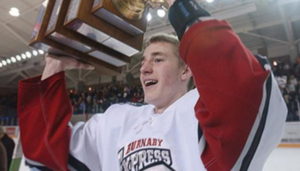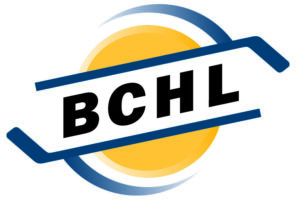As we celebrate the BC Hockey League’s 60th Anniversary season, we will take a look back at the past and celebrate the teams and people that made this league what it is today. In this edition, we go back to the 2000s, a decade which saw new highs at the NHL Draft and the introduction of new leadership.
+++
The 2000s were yet another decade of growth for the BC Hockey League. Within the decade, the league would augment its reputation amongst scouts at the highest level, establish a league office for the first time and experience expansion in the form of three new franchises.
Dominating at the Draft
 During the 2000s, the BCHL really established itself as a breeding ground for NHL teams to find talent. From 2000 to 2009, there were 59 players selected from BCHL teams at the NHL Draft, which is the most of any decade to date. The fact that there were nine rounds at the time helped these numbers, but in 2003 alone, there were 11 players taken and a year later, there were 10.
During the 2000s, the BCHL really established itself as a breeding ground for NHL teams to find talent. From 2000 to 2009, there were 59 players selected from BCHL teams at the NHL Draft, which is the most of any decade to date. The fact that there were nine rounds at the time helped these numbers, but in 2003 alone, there were 11 players taken and a year later, there were 10.
Although it did not quite match up with the numbers from 2003 and 2004, the ’07 draft may well be the most significant of the decade. From 2005 to 2007, Kyle Turris established himself as a high-end NHL prospect after putting up 193 points in 110 regular-season games with the Burnaby Express, including his last year where he came second in league scoring with 121 points as a 17-year-old. He also helped lead the Express to a league an national title in 2006.
Turris would be selected third overall by the Phoenix Coyotes at the 2007 draft and became the highest-ever pick from the BCHL and the highest ever pick of a Junior A player, a mark that stands to this day. Turris remains an NHLer and is currently in his second season with the Edmonton Oilers.
That ’07 draft featured another first-rounder from the BCHL in Riley Nash who also remains in the league and is currently a member of the Arizona Coyotes.
There was one more notable name that came from the same draft year, although he had to wait until the fifth round to hear his name called. Former Victoria Grizzlies forward Jamie Benn was selected by the Dallas Stars and became the most productive NHL player to come out of the league in the 2000s. Benn has played the entirety of his career in Dallas and is the 10th all-time leading scorer among BCHL alumni with 754 points and counting over a 13-year NHL career.
A Moment of Parity
In contrast to what we saw in previous decades, the 2000s did not feature one or two teams dominating when it comes to league championships. There were no dynasties in the decade, which indicated parity within the league was on the horizon. This point was driven home when there was a six-year span with six different champions, which was something uncommon in years past.
To start off the decade, the Chilliwack Chiefs won their second title since moving from Richmond in 1990. The year after that, it was the Victoria Salsa who captured their first Fred Page Cup in franchise history.
 A key part of that championship Salsa team was Kyle Greentree who played five seasons with the Salsa from 1999 to 2004 and ended up as the league’s third all-time leading goal scorer and point producer.
A key part of that championship Salsa team was Kyle Greentree who played five seasons with the Salsa from 1999 to 2004 and ended up as the league’s third all-time leading goal scorer and point producer.
“We had a lot of older guys,” recalled Greentree. “As we went through the playoffs, it was pretty tough. We played Nanaimo, Burnaby and Merritt. I remember a lot of Game 7s. The Game 7 at home in the finals was pretty crazy when we won it. I’m from Victoria, so friends and family were there. It was something that we all worked pretty hard towards.”
The Chiefs won it again in 2002, then it was the Vernon Vipers, Nanaimo Clippers, Surrey Eagles and Burnaby Express, who won in just their fifth year of existence and their first after moving to Burnaby. In 2007, the Clippers won for the second time in four years and the year after, the Penticton Vees won their first title in 22 seasons.
The Vernon Vipers would win it all in 2009, which was a signal of things to come in the following decade.
Expanding Again
As mentioned previously, the BCHL welcomed the Coquitlam Express into the fold in 2001. The team played there for four seasons before relocating to Burnaby in 2005. After winning the Fred Page Cup in their first year in Burnaby, the team was destined to return to Coquitlam a few year later, returning in 2010 where they have remained ever since.
 That same season saw the addition of another current-day franchise in the Salmon Arm Silverbacks. The BCHL had tried the Salmon Arm/Shuswap market in the past with the Totems/Blazers/Tigers franchise in the ’80s, but this time they got it right with the Silverbacks who have been a league member ever since.
That same season saw the addition of another current-day franchise in the Salmon Arm Silverbacks. The BCHL had tried the Salmon Arm/Shuswap market in the past with the Totems/Blazers/Tigers franchise in the ’80s, but this time they got it right with the Silverbacks who have been a league member ever since.
One other expansion team entered the fray during the decade. The Williams Lake TimberWolves began play in 2002, but their experience was short-lived. The team took a two-year hiatus from 2007 to 2009 before returning for one year and ultimately ceasing operations in 2010.
Several other teams relocated during the decade to become more familiar to current-day BCHL fans. The Chilliwack Chiefs moved to Langley to become the Langley Chiefs, who eventually turned into the Rivermen. That team replaced the Langley Hornets who moved to West Kelowna in 2006 to become the Westside Warriors and eventually the West Kelowna Warriors. The Burnaby Bulldogs, founded in 1998, moved to Port Alberni in 2002 to become the Alberni Valley Bulldogs.
Last, but not least, the Victoria Salsa ditched the muscular jalapeno pepper logo and rebranded as the Grizzlies in 2006.
A Broken Record
One significant league milestone was broken in the 2000s when Mike Di Stefano set the record for most games played with 297. Di Stefano played five seasons in the league from 2000 to 2004 and suited up for four different franchises, including the Burnaby Bulldogs, Quesnel Millionaires, Powell River Kings and Chilliwack Chiefs. He even returned to the Bulldogs for a period after they had moved to Port Alberni.
“It’s quite a privilege to be able to say [I own the record],” said Di Stefano. “I think about the fun I had, the friendships I made. and the experiences I went through. It’s a really cool thing to have. It’s something that I’ll be able to show my kids and talk to my friends about.”
The First League Office
 There was plenty to talk about on the ice in the 2000s, but the BCHL made significant strides off the ice as well. For the first time in league history, the BCHL established a league office in 2003 under the guidance of new Commissioner John Grisdale, a former NCAA and NHL defenceman.
There was plenty to talk about on the ice in the 2000s, but the BCHL made significant strides off the ice as well. For the first time in league history, the BCHL established a league office in 2003 under the guidance of new Commissioner John Grisdale, a former NCAA and NHL defenceman.
Under Grisdale’s watch, the BCHL quickly introduced a league website and eventually began live broadcasts of BCHL games, something taken for granted today.
To the dismay of some and the delight of most, the league got rid of its caveman drawing logo in 2005 in favour of the current BCHL mark that exists today.
















































